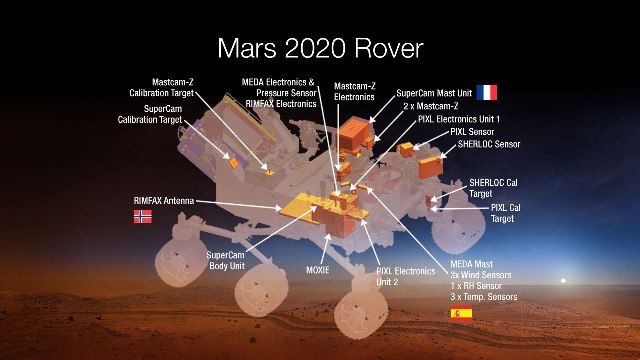 The Mars 2020 rover will bring seven instruments for scientific investigations. Mastcam-Z, a stereo camera. SuperCam, an advanced instrument with spectrometers and the ability to detect organic compounds. MOXIE, which will produce oxygen from atmospheric CO2. MEDA, a meteorological station. RIMFAX, which is a radar that can see up to 500 meters underground. There will be two instruments on the arm, PIXL for elemental analysis and SHERLOC, which is a UV spectrometer. (NASA)
The Mars 2020 rover will bring seven instruments for scientific investigations. Mastcam-Z, a stereo camera. SuperCam, an advanced instrument with spectrometers and the ability to detect organic compounds. MOXIE, which will produce oxygen from atmospheric CO2. MEDA, a meteorological station. RIMFAX, which is a radar that can see up to 500 meters underground. There will be two instruments on the arm, PIXL for elemental analysis and SHERLOC, which is a UV spectrometer. (NASA)
The Mars Group at the Niels Bohr Institute will participate in the NASA Mars-2020 mission, which will primarily focus on detecting the presence of life on the red planet.
NASA’s planned Mars missions have seen the involvement of research institutes from around the globe. Out of the 58 proposals received by NASA for experiment designs, two proposals from the University of Copenhagen based Niels Bohr Institute were selected for the mission – the MOXIE and Mastcam-Z instruments.
The head of the Mars Group were chosen by NASA’s head of the project, Mike Hecht, for their expertise and experience of space missions. The group, led by Morten Bo Madsen, were part of the Curiosity rover in 2012, Phoenix Mars Lander in 2008, Spirit and Opportunity in 2004 and Mars Pathfinder in 1997.
NASA Mars Curiosity Rover Report -- February 14, 2014
The Mars Science Laboratory Rover, Curiosity will be the base-design for the Mars 2020 Rover. The new rover will have highly advanced technical equipment and novel instruments for geological surveys. The surface of Mars will be studied to see how habitable the environment is and whether there is any evidence of prehistoric life on the planet.
Morten Bo Madsen explained that by using the Mastcam-Z, it will be possible to see distant terrain as well as zoom-in and capture a close-up view. They will assist with calibration to ensure that the obtained images are scientifically sound and realistic. A special target will be used for the calibration and the Mars Group will be designing this device.
The team will also help in the Mars Oxygen Insitu Resource Utilization Experiment, known as MOXIE.
MOXIE is an instrument developed in order to produce oxygen from the carbon dioxide found in the atmosphere, allowing a manned mission to Mars to be possible.
The Mars 2020 rover will be launched in July or August 2020, with the journey taking between seven and nine months. The experiments will be conducted by the rover for a Mars year, which is equivalent to nearly two Earth years.